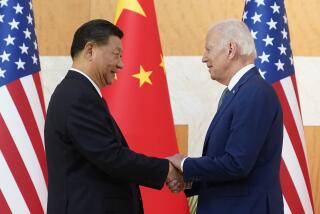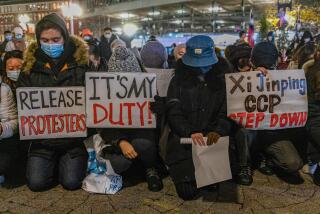China’s Xinjiang region quiet a year after ethnic riots
- Share via
Reporting from Beijing — With more than 50,000 closed-circuit cameras keeping an Orwellian eye on Urumqi’s buses, markets and back alleys, along with thousands of paramilitary officers on patrol and a fresh infusion of economic aid, China managed to slide through the dreaded one-year anniversary of the worst ethnic violence in its recent history without incident.
Urumqi, the northwestern city of 2.5 million in the Xinjiang region where 197 people were killed in riots in 2009, was quiet on Monday and “bathed in a golden sunlight,” the official New China News Agency said.
In advance of the anniversary, Chinese security had installed cameras, confiscated large knives and told suspected troublemakers not to leave their homes. Last month, Chinese authorities said they had arrested 10 ringleaders of a terrorist gang that planned bombings and other attacks around the region with help from Islamic separatists based in Pakistan.
To promote themes of social harmony, the government brought in singers and artists from Beijing.
The hard-line Communist Party chief for Xinjiang, Wang Lequan, who was widely criticized by both the Han Chinese and minority Uighurs, was removed from his post in April and replaced with a less confrontational figure.
Xinjiang has also been targeted for an estimated $15 billion in investment over the next several years. At an unusual work session attended by the entire standing committee of the Politburo in May, Chinese President Hu Jintao pledged to eliminate poverty from the region by 2020.
“The Chinese government is paying much more attention to Xinjiang since the riots,” said Wei Houkai, director of the Research Center for the Development of Western Regions at the Chinese Academy of Social Sciences. He said the program was modeled after the large-scale investment poured into Tibet, another ethnic cauldron. “When you make the ordinary people’s lives better, that can help a lot to build stability.”
Among the most ambitious of the projects in Xinjiang is a plan to designate Kashgar, a Silk Road outpost in the far west of China, as an economic development zone, along the lines of Shenzhen on the east coast. Instead of Hong Kong, trade would be with neighboring countries such as Pakistan, Kyrgyzstan and Uzbekistan.
“We have to open up the border areas the same way as we did the coast,” Wei said.
“The government is adopting a tsunami approach to investment, to submerge the region in investment,” said Nicholas Bequelin, a China expert with Human Rights Watch. The problem, he said, is that it could exacerbate Uighurs’ fear that they are being squeezed out by an influx of Chinese settlers.
“What prompted the trouble to begin with is the fear that Xinjiang is becoming more Chinese and less Uighur,” Bequelin said.
Until the riots, Chinese migrant workers in search of higher wages had been moving west into Xinjiang at a rate of about 1.2 million per year, changing the ethnic character of the region and taking many of the best jobs. Employers blatantly discriminate against Uighurs with help-wanted ads that read “Han only.”
Ilham Tohti, a Uighur economist who teaches at the Central University for Nationalities in Beijing, has written that the unemployment rate for Uighur men is among the highest in the world.
Against that backdrop, riots erupted July 5, 2009, as Uighurs held a demonstration in Urumqi to protest the death of two workers at a toy factory on the east coast. As the protest spun out of control, young Uighurs rampaged through the streets attacking Han Chinese at random in the ugliest and deadliest outbreak of ethnic violence in China in decades. Most of the dead were reported to be Han Chinese.
In a report Friday on the riots, Amnesty International complained that the Chinese authorities did not adequately investigate the killing of Uighurs in the rioting. The rights group also said that in the ensuing crackdown, security officials used “unnecessary or excessive use of force, mass arrests, enforced disappearances and torture.”
“The Chinese need to do more than crack down. They need to engage the Uighurs and draw them into the process,” said Rohan Gunaratna at the Singapore-based International Center for Political Violence and Terrorism Research and author of a new book on ethnic troubles in China. “They’ve badly needed new leadership and new thinking in Xinjiang.”
More to Read
Sign up for Essential California
The most important California stories and recommendations in your inbox every morning.
You may occasionally receive promotional content from the Los Angeles Times.













